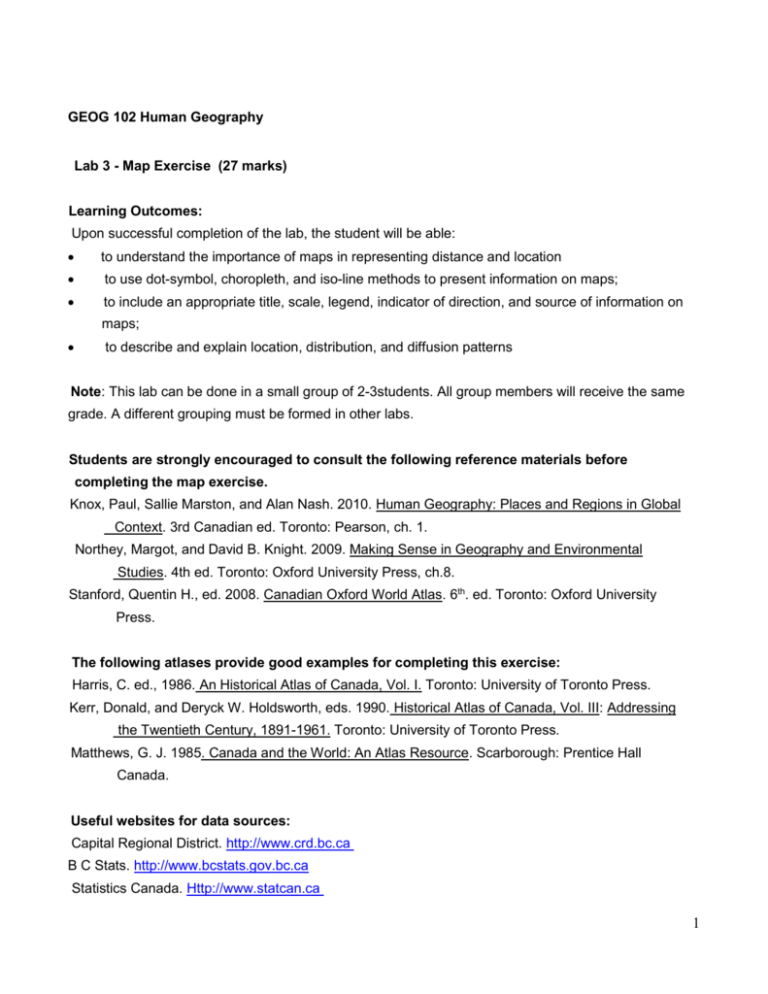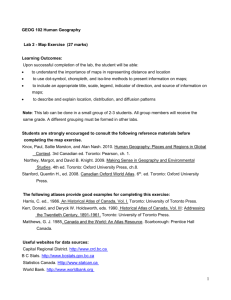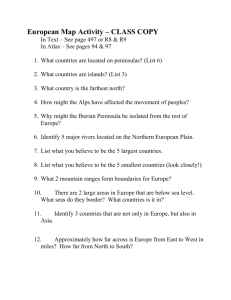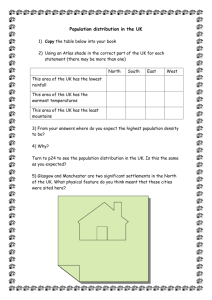GEOG 102 Human Geography
advertisement

GEOG 102 Human Geography Lab 3 - Map Exercise (27 marks) Learning Outcomes: Upon successful completion of the lab, the student will be able: to understand the importance of maps in representing distance and location to use dot-symbol, choropleth, and iso-line methods to present information on maps; to include an appropriate title, scale, legend, indicator of direction, and source of information on maps; to describe and explain location, distribution, and diffusion patterns Note: This lab can be done in a small group of 2-3students. All group members will receive the same grade. A different grouping must be formed in other labs. Students are strongly encouraged to consult the following reference materials before completing the map exercise. Knox, Paul, Sallie Marston, and Alan Nash. 2010. Human Geography: Places and Regions in Global Context. 3rd Canadian ed. Toronto: Pearson, ch. 1. Northey, Margot, and David B. Knight. 2009. Making Sense in Geography and Environmental Studies. 4th ed. Toronto: Oxford University Press, ch.8. Stanford, Quentin H., ed. 2008. Canadian Oxford World Atlas. 6th. ed. Toronto: Oxford University Press. The following atlases provide good examples for completing this exercise: Harris, C. ed., 1986. An Historical Atlas of Canada, Vol. I. Toronto: University of Toronto Press. Kerr, Donald, and Deryck W. Holdsworth, eds. 1990. Historical Atlas of Canada, Vol. III: Addressing the Twentieth Century, 1891-1961. Toronto: University of Toronto Press. Matthews, G. J. 1985. Canada and the World: An Atlas Resource. Scarborough: Prentice Hall Canada. Useful websites for data sources: Capital Regional District. http://www.crd.bc.ca B C Stats. http://www.bcstats.gov.bc.ca Statistics Canada. Http://www.statcan.ca 1 World Bank. http://www.worldbank.org United Nations Development Programme. http:// www.undp.org Useful websites for downloading outline maps: You may use an outline map from one of the following sites: The National Geographic Expeditions. http://www.nationalgeographic.com/xpeditions/atlas/index.html?Parent=world&Rootmap=cabc&Mode =b Atlas of Canada web site: http://atlas.gc.ca/site/index.html) BC Stat: http://www.bcstats.gov.bc.ca/data/pop/maps/rdmap.htm#list Capital Regional District. http://www.crd.bc.ca/maps/documents/CRD_adminbounds2009.pdf Ensure that all relevant information be included. See guideline below for details. Complete both Part A and Part B. Read instructions carefully in Part A. Write short answers in Part B. Writing must be legible to get marks. Part A. Map Exercise (20 marks) Create one of the following maps on a sheet of 22 cm. by 28 cm. (8.5" x 11") paper : i) A map showing the growth rates of population or employment in the Capital Regional District of Victoria in the past ten years; ii) A map showing the location of a retail chain (with a minimum of 10 stores) in BC iii) A map showing the location of cities (10,000+) and towns (1,000-10,000) on Vancouver Island within 50, 100, and 150 km zones of Victoria. iv) A map of any geographical region (ranging from a neighbourhood to the whole country) with a specific human activity theme, such as, population distribution, patterns of communication or transportation system, location of industry, retail services, or cities. The use of appropriate methodology is important in mapping. Use a dot or symbol map to show exact location of population or economic activity. A choropleth map is used to show regional variations of an activity. An iso-line map is applied to show places of equal value (such as equal distance, etc.). See also examples in Knox, pp. 30-35. Students are allowed to copy the outline of a region/country from a map or atlas but should incorporate information or data from other sources. Copying a map directly from an atlas or other 2 sources will not allow students the opportunity to achieve the learning outcomes as indicated above and is considered plagiarism. A mark of zero will be assigned in such case. The map is evaluated according to the following criteria: there should be a margin of at least 2.5 cm on each side of the paper (8.5” x 11”); the map should have a specific objective which clearly describes by its title (including subject, region, and year of data); the map should have an appropriate scale corresponding to the details of materials (scale can be shown in linear scale, representative fraction or scale statement) (Stanford, p. 8); the map should also indicate its position with latitudes and longitudes and labelled also their directions and degrees; all symbols must be consistently drawn and applied (e.g. ensure all boundaries, international, provincial, and municipal, and coastlines are properly differentiated); the map should have a legend to explain all symbols used; information presented on map should use an appropriate method with consistency and balance in design; the map should include the sources of data which you have consulted and gathered information (use style guides, such as APA, MLA, or SSS, for citations and documentation); Useful steps to create a map: 1. Choose one of the map options and identify the major focus (theme and place/region) of your map; 2. You may use an outline map from the Atlas of Canada web site or the National Geographic web sites or atlases identified above or other appropriate sources. You may enlarge or reduce the outline map by a photocopier as needed (and adjust the scale on your map page if necessary). Ensure that all information are appropriately presented and included 3. Consult and collect relevant statistical information or other sources of materials for your map; 4. With the help of an atlas, determine the boundaries, direction and position of the place or region of your map; 5. Use the most appropriate methodology (choropleth, dot-symbol, or isoline) to present the information on the map; 6. Included all necessary details (but do not over done) to make the map meaningful and clear to your audience; 7. Draw a rough draft to ensure a good balance in your design and the details included; 8. Have a fun time drawing the map! 3 Names Student No.: Section No.: Part B. Based on your map in Part A, answer the following questions (7 marks): 1. What is the scale on your map (in representative fraction) 2. What is the distance on earth between the two points farthest apart on your map? 3. What is the absolute location of your map (identify the range of latitudes and longitudes for a large area)? 4. What is your method of presenting information (choropleth, isoline or dotsymbol)? 5. What is the advantage of using this method over others? 6. Describe one of the spatial characteristics (e.g. its location, distribution, or diffusion pattern) that you can identify on your map. 7. Explain briefly what factor contributed to the location, distribution, or diffusion pattern that you identified above. 4






